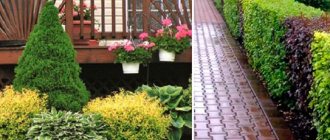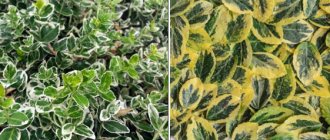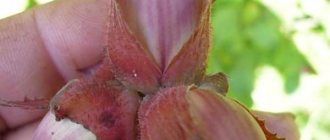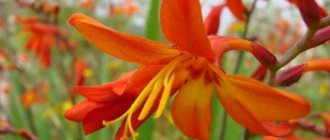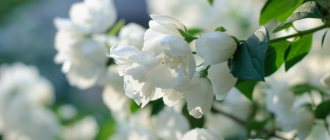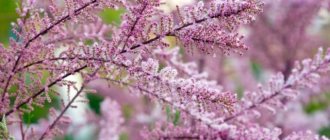Author: Natalya Category: Garden plants Published: January 20, 2019Republished: February 20, 2019Last edits: November 03, 2020
- Growing conditions
- Reproduction methods
- Preparing for winter
- Amur bladderwort (Physocarpus amurensis)
The plant bladderwort (lat. Physocarpus) belongs to the genus of deciduous shrubs of the Rosaceae family. The Latin name for bladderwort comes from two ancient Greek roots: “physo”, meaning bubble, and “carpos”, meaning fruit. The genus includes 14 species native to East Asia and North America. In cultivation, the bladderwort shrub is an unpretentious plant that does not lose its decorative effect throughout the growing season. It also stands out for its resistance to air pollution and its rapid growth rate. The bladderwort is used in landscape design and as a solo plant, but the hedge made from the bladdercarp looks most impressive.
Planting and caring for bladderwort
- Planting: in spring or autumn.
- Flowering: for two to three weeks in the first half of summer.
- Lighting: bright sunlight or partial shade.
- Soil: optimal - loose, fertile, well-drained and lime-free loam, but other soil will do.
- Watering: strictly at the root, early in the morning or after sunset. In hot weather - twice a week with a water consumption of up to 40 liters per adult bush.
- Feeding: in spring and autumn.
- Pruning: in the spring, before the buds swell - sanitary and formative, in the fall, during leaf fall - sanitary. Anti-aging pruning will be needed in the sixth or seventh year.
- Reproduction: by seeds, layering, cuttings and dividing the bush.
- Pests: practically not affected.
- Diseases: chlorosis.
Read more about growing bladderwort below.
Diseases and pests
Another advantage of the bladderwort is that it is practically not affected by diseases and pests. It is rare to observe leaf chlorosis - when the tips of the shoots dry out and the foliage turns yellow, the veins remain green. This is due to a lack of microelements in the soil: elements of iron, magnesium or nitrogen, or waterlogging of the root ball. Chlorosis can be caused by viruses and microorganisms that are carried by pests. Applying complex fertilizers with watering or spraying the foliage with chelated compounds will help the bladderwort restore health.
Bladderwort diseases mainly occur due to improper care
Bladderwort is good as a solo plant and excellent as a living fence in mixed group plantings. Even the bark of this shrub is decorative. Leaves and flowers that change shades throughout the season will add contrasting color variety to the green decoration of the garden area.
Bladderwort in the garden: video
Growing bladderwort: photo
Botanical description
The vesicular carp bush is distinguished by spreading drooping branches that form a dense crown in the shape of a ball. In mature bushes, the bark peels off in wide strips. The height of the vesicular carp is up to 3 m, the leaves are three-five-lobed, resembling the outlines of viburnum leaves. The flowers are white, simple, with numerous stamens, collected in hemispherical inflorescences with a diameter of 5 to 7 cm and abundantly covering the bush in early summer. The fruits of the bladderwort also look attractive - swollen leaflets that turn red when ripe.
In culture, bladderworts are represented by only two species, which have several very attractive varieties for gardeners with leaves of different colors.
Popular red-leaved varieties
Those belonging to this subgroup prefer sunny, open places. In the shade they do not have the opportunity to fully open and bloom. Thus, from a beautiful red, in the shadow areas you will get a regular green.
Diabolo
A very beautiful variety, has a beautiful appearance. The leaves are endowed with a glossy purple color, as well as a spreading crown. Grows 3 m in height, needs pruning.
With the onset of spring, it does not lose its original appearance, however, in shady areas where there is not enough light, it will easily lose its proper beauty.
Red Baron
The crown has a spreading shape, up to 2 m in height and about the same in width.
In autumn the leaves change color to bronze.
Summer Vine
Translated, the name will be Summer Wine. The crown is endowed with a spreading type, wine-colored foliage in a metallic shade. Reaches 2 m in height, with the onset of spring lush flowering is observed, white inflorescences appear.
Quite resistant to low temperatures.
Lady in Red
The foliage is a faint red hue, the flowers are about the same pink color.
It reaches a height of no more than 1.9 m. In autumn the foliage darkens.
Andre
It grows 2 m in size, the foliage is orange, at the beginning of summer this color changes to bronze with red tints.
The leaves are medium in length, about 10 cm. Flowering occurs in June with white flowers.
Shuh
The foliage, like that of Summer Vine, has a wine tint; flowering begins towards the end of spring, characterized by the appearance of pink flowers.
It reaches a width of 2 m. It has good resistance to low temperatures and sudden changes.
Little Angel
The variety has a telling name, reaching a maximum of 1 m in width and height. The leaves are also small in size.
They are endowed with an orange tint, which after time becomes burgundy.
Midnight
It is the most gloomy and dark of the existing subspecies of bladderwort. Mature shrubs are endowed with dark burgundy leaves.
At the same time, the flowers on this plant grow in a pinkish hue. It is 1.8 m high and 1.5 m wide. In autumn, the shade of the leaves changes to orange.
Little Joker
It also has a self-explanatory name and small purple leaves. In autumn the foliage turns brown.
However, the flowers remain white throughout.
Teenie Vine
1.3 m high, less than 1 m wide. It is an excellent solution for those who want to decorate a small garden.
The foliage has a dark burgundy tint. The inflorescences are white with pink tints.
Planting a bladderwort
When to plant
For planting, purchase bladderwort seedlings with a closed root system from a garden center or nursery - such planting material can be planted at any time except winter. Bare-rooted seedlings are planted in spring or autumn, although planting bladderwort in autumn is still preferable. Choose an open, sunny area for the bladderwort, away from large trees. If you plant a variety with green leaves, it will grow well in partial shade.
- Raspberries: growing in the garden, propagation, varieties
The vesicular carp has only two requirements for the soil: it should not contain lime, and it should be well-drained - the plant doesn’t care about anything else. True, it is worth saying that on loose, fertile loamy soil the plant will have a more lush, elegant and vibrant appearance.
How to plant
The hole for the bladderwort will need to be of such a size that a layer of fertile soil (or a mixture of soil, peat, sand and turf) can be placed in it and so that the root collar of the seedling is at surface level. Therefore, it is better to dig a hole and place the fertile layer in it a week or two before planting, so that the soil has time to settle.
The vesicular carp seedling is placed in a hole without removing the soil from the roots, so as not to injure the plant, and it is better not to add fertilizers to the soil when planting, since the young plant in a new place will not be able to absorb them. Fill the hole with fertile soil or a soil mixture of the composition described above and water the plant generously. If the soil settles, add more soil. At first, make sure that the soil around the seedling is slightly moist at all times. Mulch the area with the bladderwort with peat or humus.
Bladderwort propagation by cuttings in summer, spring and autumn
How to propagate bladderwort by cuttings
Bladderwort is a crop that can delight and decorate a piece of land not only with attractive buds, but also with quite beautiful foliage. This species is often called Meadowsweet or Spiraea viburnum. As practice says, the plant is perfect for making a vegetable hedge, as it tolerates the process of hairstyle and shaping very well. If you need planting material, you can choose it in a special store or propagate the vesicle carp from cuttings in the summer on your own.
Characteristics of propagation of viburnum leaf by cuttings
For propagation, you need to use mature bushes without obvious signs of disease. Also, do not use weak plants. To work, you need to choose a sharp knife with which you can cut the required number of cuttings.
When is the best time to take cuttings?
As practice and reviews from experienced gardeners say, you can carry out summer, spring and autumn cuttings of bladderwort. It is best to propagate the crop in the summer. This is primarily due to the fact that in such a case all the characteristics of the mother bush will be transferred to the plant. This propagation option is excellent when it is intended to plant a decent amount of bladderwort on the site, but there is not enough material for planting.
Propagation of bladderwort by cuttings in summer
Since cuttings are considered a fairly popular method of propagation, it is also perfect for bladderwrack. In this case, it is best to carry out the work in the first half of summer, before the flowering period begins. The shoots must certainly be this year, green. The length of the cuttings should be at least 20 cm, and each should have about 4 nodes (growth points).
Propagation of bladderwort by cuttings in spring
If necessary, you can carry out cuttings of the bladderwort in the spring. To do this, you need to select the healthiest and strongest shoot from the very beginning, remove the leaves, leaving only the leaf plates on the top. The work must be done carefully so as not to harm the mother bush. Young green shoots should be about 10-15 cm in length. The lower cut should be made at an angle of 45 degrees, just below the bud.
Propagation of bladderwort by cuttings in autumn
It is recommended to carry out cuttings of vesicular carp in the fall in the very morning or in bad weather, which will make it possible to significantly reduce the amount of evaporation. For propagation, the length of the cutting should be approximately 10 cm. The upper cut is always straight, while the lower one should be made at a small angle. The leaves are generally cut off approximately partially.
How to propagate bladderwort by cuttings
Propagating bladderwort by cuttings is very simple, as it may seem from the very beginning. As practice says, anyone can perform such work even without great abilities. The work can be done in summer, spring or autumn - each gardener chooses a time convenient for himself.
Rules for taking cuttings
To propagate the crop, it is important to select and cut the cuttings correctly. In this case, give preference to young and strong shoots. In many cases, the leaves are virtually all removed, as they take up a fair amount of the nutrients needed to form the root system. The lower cut is primarily oblique, and it is recommended to plant the cutting at a slight angle.
Preparation of cuttings
It is necessary to understand not only how to propagate vesicles by cuttings, but also how to properly process the material for planting, plant it in a permanent place of growth, and perform care. In order for the root system to emerge as quickly as possible, it is recommended to place the cuttings immediately after they have been cut in a container with a growth stimulator. Basically, such preparations are diluted in water, after which the cuttings are soaked for a period of 12 to 24 hours. In most cases, you can choose a rooting agent in powder form, which you simply sprinkle on the bottom.
A day after soaking in the growth stimulator, the material is planted in specialized school beds, where a mixture of sand and peat is used as soil. The containers are covered with a polyethylene-based film or a lid made of plastic. During the rooting process, it is important to sometimes ventilate the cuttings and irrigate the soil. In the spring, by and large, they are planting them in a permanent place of growth.
Caring for cuttings
As soon as the cuttings have been cut and planted in nutrient soil, we can assume that the propagation process is approximately partially completed. Until the planting material is planted in a permanent place of growth, it should also be given the necessary attention. In this case, you need to remember about the drip irrigation system for the soil - it must be wet, the cuttings must receive a large amount of moisture. Since in many cases the containers are covered with a polyethylene-based film, it is sometimes worth removing it and ventilating the vesicle.
Transplantation to a permanent place
For planting, it is better to select an open area that receives a decent amount of sun. In order for a fairly luxurious crown to emerge during the formation process, and for there to be many buds on the shoots, it is necessary to select a site with soil with black soil, and there should be absolutely no lime.
The hole must be prepared in such a size that the root system of the cutting with an earthen lump completely fits into it. Fruitful soil is generally poured into the hole 14 days before the planned time of planting. It is important to ensure that the root collar is located at the same level with the soil surface.
After planting, the planting material is well watered. If, for example, the earth settles, add the required amount of earth. In order to retain moisture for a very long time, it is recommended to mulch the ground.
Bladderwort care
Growing conditions
The most important point in caring for the plant is timely watering, since the bladderwort does not tolerate drought. When moistening the soil, water should not get on the leaves or inflorescences of the vesicular carp, as this may cause burns on them. Therefore, it is better to water the plant early in the morning or late in the evening. The approximate frequency of watering in the hot season is twice a week, the amount of water for an adult bush is 40 liters. Monitor the condition of the leaves of the plant, because both a lack of moisture and its excess are harmful to the bladderwort.
After watering, if you have not mulched the area, you need to loosen the soil and remove weeds. The bladderwort is fertilized twice a year - in spring and autumn. In the spring, for feeding, use a solution of a half-liter jar of mullein, a tablespoon of ammonium nitrate and the same amount of urea in 10 liters of water at the rate of 15 liters of solution per adult plant. In autumn, the tree trunk circle is watered with a solution of nitroammophoska at the rate of 2 tablespoons of fertilizer per 10 liters of water at a consumption of 15 liters of solution per adult bush.
Trimming
The bladderwort in the garden needs both formative and sanitary pruning. In the spring, mandatory sanitary pruning is carried out, removing broken, diseased, frozen branches and shoots, as well as those growing inside the bush. Pruning bladderwort in the fall is necessary to prepare the shrub for winter. Formative pruning can also be done in the fall, although it is wiser to do it in the spring.
- The most beautiful shrubs for a summer cottage
If you want to have a wide bush, cut the vesicle at a height of half a meter, and if you are attracted by the shape of the fountain, cut out all the thin shoots at the base, and only slightly shorten the remaining 5-6 strongest ones. Rejuvenating pruning of the bush to a stump is done in the sixth year of the vesicular carp's life. Cuts on thick shoots are treated with garden varnish.
Transfer
Sometimes it becomes necessary to transplant a vesicle - either the place is not suitable for it, or your plans for it have changed. Transplantation of an adult bladderwort is carried out in the spring before the buds awaken or in the fall, after leaf fall. They replant the vesicle with a large lump of earth, having first trimmed the bush - removing all unnecessary, diseased and thickening shoots, and shortening the rest to 20-30 cm. This is done in order to reduce the load on the root system, which will find it difficult to simultaneously adapt to a new place and feed the adult bush.
Transplantation is carried out according to the same principle as primary planting, with the adjustment that you are not replanting a seedling, but an adult bush. After transplanting, water the vesicle with a solution of Kornevin or Heteroauxin, and treat the leaves with Ecogel-anti-stress or Epin.
Pests and diseases
As you can see, even an inexperienced gardener can plant and care for vesicles; moreover, this shrub is very resistant to diseases and pests and is almost not affected by them. Sometimes, due to poor nutrition, it may develop chlorosis, which is expressed in yellowing of young leaves and drying out of the apical shoots. In this case, you will have to add iron to the bladderwort diet by spraying the leaves or watering the roots with a solution of Antichlorosis, Ferrylene, Ferovit, and best of all, Iron Chelate. Usually after this the plant’s health is restored.
Nuances of care
Caring for diabolo is quite simple. If optimal conditions are created for it, then even in the first year the crop will grow to 40-50 cm. It can live in one place for up to 30 years. The requirements for watering the bladderwort are as follows:
- if the crop grows in a hot climate in loam, then it must be moistened twice a week;
- In clay soil, it is better to avoid waterlogging, otherwise the roots will rot;
- young seedlings should be watered as often as possible, because during this period they need a lot of moisture to adapt.
The bladderwort needs shaping and sanitary pruning. The sanitary procedure requires the removal of dead and dried branches. It is recommended to prune the plant for formation in autumn or spring. Thus, it is possible to achieve not only an improvement in the decorative properties of the crop, but also to activate its growth. The shrub takes well to pruning.
Reproduction of bladderwort
Reproduction methods
At home, the bladderwort propagates vegetatively - by layering, cuttings and dividing the bush. You can, of course, sow bladderwort seeds in the fall or spring, having previously subjected them to monthly stratification, but the fact is that grown seedlings rarely inherit the bright color of the foliage of the parent plant, and there is a lot of fuss with them, while vegetative methods of propagating bladdercarp are more convenient , and more reliable, and give quick results.
Propagation by cuttings
To make cuttings, you need to cut off the green shoots of the current year, 10-20 cm long with two or three internodes, before the start of flowering of the vesicle, remove all the leaves from the lower part of the shoots, and shorten the leaves in the upper part of the cutting by half. Then the cuttings are soaked in a solution of root or any other root formation stimulator, planted in a training bed in a mixture of sand and peat, watered and covered with plastic film. Caring for the cuttings consists of regular watering and ventilation. For the winter, the rooted cuttings are covered, and in the spring they are transplanted to a permanent place.
Reproduction by layering
This is the easiest way to get a new plant. In the spring, select a strong, healthy shoot directed outward, remove all leaves from it except those growing at the top, place it in a 12 cm deep groove made in the soil, pin it with wooden staples or regular hairpins and fill the groove with soil. During the growing season, do not forget to water the layering, loosen the soil around it and remove weeds. In the fall, separate the rooted cuttings from the mother bush and cover them for the winter.
- Varieties of lilies
Dividing the bush
The easiest way to reproduce is by dividing the bush. This should be done in the spring or autumn, but if you have the skill to dig up and transplant plants, then you can divide the bladderwort bush in the summer - in this process, the most important thing is speed of execution, so that the roots of the bush removed from the ground do not have time to dry out.
Rules for propagating viburnum-leaved bladderwort by cuttings
Selected varieties provide planting material that retains varietal characteristics only through cuttings. You can propagate the crop on the site by dividing the mother bush, but this option is only suitable for a perennial, overgrown crop. And an adult plant takes root worse than young seedlings.
A plant no younger than five years old is suitable for vegetative propagation. By this time, the bladderwort has completely completed the formation of the root system and all the nutrients are used to build up green mass. Therefore, material from such bushes is obtained with high viability. Bladderworts that are infected, weak, or have sparse flowering and a loose crown are not considered for propagation.
Bladderwort in winter
Preparing for winter
In the fall, the bladderwort is amazingly beautiful, when the monochromatic foliage begins to dapple with autumn colors. Bladderwort is a fairly frost-resistant plant, and usually in winter only young immature branches freeze on adult bushes, but the cuttings of bladderwort that have taken root in the fall, as well as young bushes, are covered for the winter.
Overwintering of the bladderwort
How to cover a bladderwrack if you are expecting a frosty winter? Carefully tie the bush with twine and cover it with a cone of roofing felt. You can loosely wrap the bush with lutrasil. But first, the soil around the bush needs to be mulched with a layer of peat 5-8 cm thick. After pruning and mulching the tree trunk, it is better to cover young bushes with spruce branches.
Popular yellow-leaved varieties of bladderwort
Just like red-leaved varieties, these varieties need sunlight to reveal their entire color palette.
Luteus
It can grow up to 3 m in height, with a crown diameter of 4 m.
Throughout the year, the foliage changes color.
Darts gold
Average height, 1.6 m.
At the time of blooming, the leaves have a light shade, in the summer they change to a green transition, and in the fall they turn bronze and yellow.
Nugget
Medium height, up to 2 m tall.
The leaf blades are also small, at the time of flowering they are endowed with a faint yellowish color, but then acquire a green tint.
Enis gold
It differs from the others in its variegated leaves.
The bush itself is quite small, with a crown in the shape of half a ball.
Amber Jubilee
Belongs to the British selection, most in demand in matters of decoration.
A distinctive feature is the small crown, reaching 1.5 m.
Aurea
Medium height, 2.5 m high.
The foliage does not change its bright yellow color during flowering. However, in the fall it turns golden.
Types and varieties
Currently, only two types of bladderworts, as well as their varieties and varieties, are grown in garden floriculture.
Amur bladderwort (Physocarpus amurensis)
This is a shrub from the mixed forests of Northern China, North Korea and the Far East with a spherical crown. It reaches a height of 3 m. Young shoots of plants of this species are smooth, reddish-brown, and the bark of old trunks peels off in longitudinal stripes. The leaf of the Amur vesiculus is three- to five-lobed, with a heart-shaped base, up to 10 cm long, dark green on the upper side and grayish-whitish with tomentose star-shaped hairs on the lower side. White flowers up to 1.5 cm in diameter in quantities of 10 to 15 pieces form a corymbose inflorescence and bloom for three weeks. The fruit is a swollen leaflet that turns red as it ripens.
The Amur bladderwort is winter-hardy. It is used in single and group plantings and hedges. It has been in culture since 1854. The following forms of Amur bladderwort are known:
- vesicular carp Luteus with bright yellow leaves in summer and bronze in autumn;
- Aureomarginata is a vesicular carp with a dark golden border on the leaves;
- Nana is a dwarf variety, the leaves are single-colored, dark green.
Physocarpus opulifolius
Originates from eastern North America, where it grows along river banks and in undergrowth. This shrub reaches a height of 3 m, its crown is dense, hemispherical, the leaves are three-five-lobed, elliptical, with a large elongated middle lobe, jagged along the edge, green above, lighter below, sometimes with pubescence. Flowers up to 12 mm in diameter are white or pink with red stamens. The fruits are swollen aggregate leaflets, initially light green, but turning red as they ripen.
In landscape design, viburnum-leaved bladderwort is used alone and in a group, including for creating a hedge. In culture since 1864. The most famous varieties:
- Darts Gold vesicle is a wide and dense shrub up to 1.5 m high with yellow leaves that turn green in summer. Flowers in racemes are pink or white;
- Red-leaved bladdercarp, or Diablo bladdercarp, is a shrub up to 3 m high with dark red or purple leaves. Planting and caring for the Diablo vesiculus absolutely complies with our recommendations, with the adjustment that when grown in bright sun its leaves are red, and in the shade they are green with a purple tint. It is characteristic that with the onset of autumn the color of the leaves does not change. This is the most popular variety of viburnum;
- vesicular carp Red Baron , up to 2 m high with three-five-lobed oval, bare, serrated along the edges leaves up to 7 cm long of a luxurious dark red color, which are slightly narrower than Diablo, looks very impressive, and white flowers with a pink tint in umbrellas with a diameter of up to 5 cm make it even more elegant. The bush is also decorated with red fruits, consisting of 3-5 pointed sacs. This is one of the most valuable varieties of bladderwort;
- Lady in Red, up to 1.5 m high, is an English variety with bright red leaves that darken over time and delicate pink-white flowers.
Features of the vesicular carp
The spreading bush of the bladderwort consists of drooping branches that form a lush spherical crown. In an adult shrub, the bark peels off in wide stripes. It can reach 300 centimeters in height. The three- to five-lobed leaf blades are shaped like viburnum leaves. Simple white flowers have many stamens. They are part of hemispherical inflorescences, which can reach 5–7 centimeters in diameter. Lush flowering occurs at the beginning of summer. The fruits of such a plant also look quite impressive; they are swollen leaflets that turn red when ripe. Only 2 types of bladderwort are cultivated, although there are several spectacular varieties whose leaf blades have different colors.
Hedges: Physocarpus opulifolius 'Diabolo' and 'Luteus'
Landing
Of course, planting a bladderwort, like any plant, begins with choosing a suitable location. Bladderwort grows well both in the sun and in the shade. It grows poorly on soils with high groundwater levels and high lime content. Such soil can provoke chlorosis or rotting of the roots, which will lead to the death of the bush. The plant does not impose any special conditions on soil fertility.
You can safely plant the plant as a hedge along the road, since the bladderwort tolerates urban air pollution very well.
The bladderwort is completely unpretentious to the planting site
It is better to purchase a plant for planting with a closed root system in nurseries. This way you will have a guarantee of purchasing a varietal seedling. Container seedlings can be planted at any time, excluding the winter months. Planting material with an open root system is planted in spring or autumn. Autumn planting is preferable, since the conditions for rooting are more favorable than in spring.
There are no tricks when planting: a hole is dug so that the root collar is level with the ground surface. Filled with fertile soil composition and well watered. The top is mulched with humus, peat or just dry soil.
Bladderwort seedlings
To obtain a hedge from bladderwort, young seedlings are planted in a two-row manner in a checkerboard pattern. A distance of 35 cm is left between the rows, and 45 cm in the row. Such a hedge can be formed by pruning, giving it the appearance of a meter-high rectangle. A free-growing hedge, limited only by pruning on the sides, will grow 1.8 - 2.5 m, depending on the variety planted.
Description
The foliage takes on a reddish hue in autumn. In winter, it tolerates frost well; dry soil is also not an obstacle for the bladderwort. It is believed that this is the most unpretentious plant for the garden. Its lifespan is about 25 years.
It took this name because of the unusual fruits that look like a bubble. There are about 14 species, and more than 200 varieties. Obtained by crossing hybrids and natural methods. The difference lies in the color of the leaves and the size of the bush itself.
Landing rules
Before planting the plant, you need to choose a good place. The bladderwort feels great in completely open areas that are illuminated by the sun. The bushes also grow well in the shade, but in such conditions they lose their attractive color.
This plant is not very picky about soil composition. However, the close occurrence of groundwater can cause rotting of the root system. It is noteworthy that Diablo perfectly adapts to dust and gas pollution, so it can be planted near:
- highways;
- parks;
- pedestrian crossings;
- railway stations and so on.
It is best to purchase seedlings from a special nursery. There shouldn't be any problems with planting them. To do this, make a spacious hole, at the bottom of which you need to make a drainage layer. It is also advisable to pour some fertile soil into it. When planting a seedling, its roots need to be thoroughly straightened.
Bladder carp viburnum leaf care
If the bladderwort receives proper care, it lives on average 25 years. During the growing season it develops very quickly, gaining up to 40 cm in both width and height. It tolerates frosty winters well even without shelter, although severe frosts can damage the tips of the shoots.
Watering
The plant does not tolerate drought, so it is important to water it on time and abundantly. Make sure that no water gets on the inflorescences or leaves when watering, otherwise they may get burned.
Accordingly, it is better to carry out the procedure early in the morning or late in the evening. In summer, it should be carried out twice a week, pouring 40 liters of water under each adult bush. If the soil around the bush is not mulched, after each watering it is necessary to remove weeds and loosen the soil.
The frequency of watering is also influenced by the nature of the soil, the age of the plant, and the climatic zone. If the bladderwort grows on loam in a hot climate, watering begins in spring and ends in autumn. On clay soils there is a danger of flooding the plant. If there is excess moisture, it can die or get sick.
Top dressing
Plants are fertilized twice a year: in spring and autumn. In the spring, mullein is used by dissolving 0.5 liters of fertilizer, a tablespoon of urea and ammonium nitrate in a bucket of water. One adult bush requires 15 liters of this mixture.
Important! If there is a need to transplant an adult bush to another place, it must first be trimmed and then moved with a large lump of earth, adhering to the rules of primary planting. All diseased, dry, thickening shoots are pruned, and the rest are shortened by 30 cm
Then a solution of “Heteroauxin” or “Kornevin” is poured under the root, and the leaves are treated with “Epin” or “Ecogel-anti-stress”. Transplantation is carried out either in the spring before the buds awaken, or in the fall after dropping the leaves.
In the fall, prepare another mixture: take 2 tablespoons of nitroammophoska per bucket of water. Feeding consumption is the same.
Trimming
The bush requires both sanitary and formative pruning, since it develops very quickly. In the spring, shoots that grow inside the bush, as well as diseased, broken, and frozen shoots are removed.
During the same period, it is recommended to do formative pruning of the vesicle, although it is permissible to do this in the fall. To do this, the branches are cut at a height of half a meter, then you will get a wide and spreading bush. If you want to have a lush top, but a modest base, you need to cut off the thin shoots from below, leaving 5 - 6 main ones, shortening them slightly.
In the sixth year of the bush’s life, it is necessary to carry out anti-aging pruning by removing the plant onto a stump. This is done at a height of 40–50 cm from the ground, then the bush will grow wide and powerful. With any type of pruning, the cut sites must always be treated with garden varnish to prevent infection from entering the plant through them.
Did you know? The bush has found its place in landscape design. Thanks to its rapid growth and lushness, the viburnum leaves form a beautiful hedge. It is also used to decorate borders and solo plantings.

